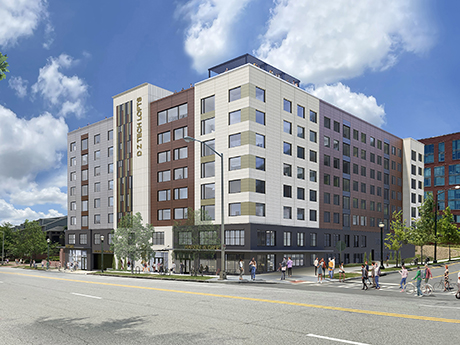Following a renaissance in the quality of university student housing, along came the COVID-19 pandemic to further redefine the “college experience.” Students were suddenly forced to attend classes remotely from homes, apartments, and dorm rooms. In time, many students began to appreciate the freedom and comfort of living in a variety of housing options while enrolled in college coursework. As classrooms have since reopened, student housing has become a rapidly changing landscape in university architecture and design.
A unique new project at Georgia Institute of Technology (Georgia Tech) in Atlanta incorporates the influence of a private developer’s goal of creating an apartment complex for students directly adjacent to campus, reflecting desirable student housing ideals — but apart from the university system.
Impactful Zoning
The new 564 Centennial Olympic Park Drive building contains 100 furnished units, mostly four bedroom/four bath, with a handful of other configurations from single studios up to five bedrooms, for a total of approximately 307 beds. The size of the building was an indirect result of zoning restrictions: the original site plans were maintained to avoid a complex re-zoning process. The building is eight stories, with a courtyard, rooftop deck, and two-level parking garage, wrapping a variety of commercial/retail spaces on the ground floor.
One of the project’s most demanding challenges was that the developer’s pro forma goals required the maximum square footage and beds possible. With the size and height limitations mandated by zoning restrictions, the design process became jigsaw puzzle-like in placing attractive, livable units while maximizing the building space.
Insights to Livability
A C-shaped floor plan was selected to satisfy the zoning restrictions, mandating a maximum building footprint, while still optimizing windows for natural daylight. The C-shape was a deliberate accommodation of several factors. The previous zoning that had been approved was for a unified development plan and the parcel area had already been laid out in a C-shape. Designers had considered other configurations, such as L-shape and doughnut, but found that the C-shape, with a south-facing open side allowed for the most natural light.
As opposed to traditional dorm “shotgun” style units with a single transom window at the end, the plan includes a window in every bedroom and living room. The units are efficiently organized with standardized groupings of bed and bathroom units, incorporating four beds and four baths within 1,250 square feet. Bedrooms are relatively small, but well illuminated by 6X6-foot windows. To reach standards, the team looked at other student housing apartments and dorms as a baseline. Sufficient space in each unit was planned for a full-size bed, dresser, closet and desk in the furnished units. The dorm-style layout design was enhanced with Federal Housing Administration (FHA) compliant bathrooms and kitchens. The team attentively programmed all the pieces until arriving at the most livable solution.
Discoveries in Common Spaces
A significant aspect of the project’s plan is the plentitude of shared common spaces. Lounge areas — a critical element in student housing, not found in most traditional apartment floor plans — include study rooms and lounge/community rooms placed on every floor. The largest of these spaces are on the eighth floor, near elevators for access to the roof deck, and on the third floor, serving the amenity courtyard and pool deck.
The team was able to optimize the budget by squeezing some of these shared spaces into the windowless corner areas of the building, inevitable in the C-shaped configuration. Usually reserved for elevators and MEP (mechanical electrical plumbing) infrastructure, corners can also function as lounges or study spaces. As students occupy these spaces for only a few hours at a time, the presence of windows is less critical than it would be in a full-time living space.
In addition to zoning restrictions, the Georgia Tech student residence plan also needed to accommodate the site’s substantial slope. Because the incline was both north-south and east-west, two levels of parking could be incorporated without a ramp, for a significant cost savings. The design also maximized the number of parking spaces by being able to enter both sides from access roads—one at lower ground level and another, even with the second level on the opposite side of the site. Because the building is located close to public transport, no minimum number of parking spaces was required, as many student residents are expected to use transit, walk, or ride bikes to campus.
Some of the new ground that the university design team encountered in this project, such as working with private developers and designing within rigid zoning constraints, resulted in creative, innovative solutions. Finding ways to optimize space led to unique lounge and study spaces, while the organic topography of the parking garage resulted in huge cost savings as well as a more functional design. The finished building will be attractive to graduate students and others who wish to live in a building that has convenient proximity to campus, but not in a dorm — a concept growing in popularity uplifting the collegiate experience off campus.
—Laura Morton, AIA, is a senior architect and senior associate at SSOE Group, an architecture and engineering firm.


